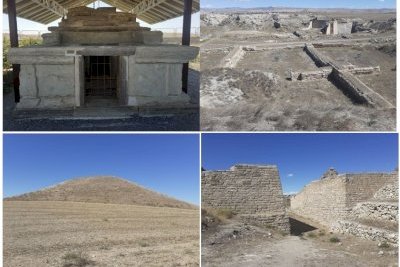
Site visited in September, 2022. Turkish candidate for inscription in 2022. Huge chances as the area was once the capital of powerful Phrygian Kingdom traces of which are still visible. They are located within and near modern Turkish village of Yassıhüyük.
While you approach the village you can spot a lot of artificial hills, some as high as 30 meters. They are mounds covering graves of Phrygian rulers and Hellenistic elite. The biggest of them is located just outside the village, next to Gordion Museum. And probably , museum is the best starting point to explore the area not only because of the necessity to buy a ticket but also because of valuable information and historical context you may get while visiting the museum. It contains artefacts from all prehistorical and ancient periods of human settlement in the area. Outside the main building but still within museum premises there are larger objects (tombs, mosaics) taken from places nearby and reconstructed.
On the other side of the main road there is an entrance to Midas Tomb (same ticket), the second biggest mound of Turkey. It was named after Midas although recent studies mostly assign it to Midas father, Gordias. Whoever it was the whole tomb is quite imposing. Inside the tomb, there is original wooden structure covering the tomb. Main corridor leading to the tomb was constructed by Turkish engineers in the 50-ties of XX century.
Main excavations and former Phrygian capital are located on other side of Yassıhüyük village. Area is fenced with tables in English describing different aspects of life in Phrygian times. The most imposing are uncovered fragments of main entrance (gate from 900-800 BC), foundations of terrace buildings and overall layout – from citadel mound you can spot two small hills – Kustepe (Bird Mound) to the North and Küçük Höyük (Little Mound) to the south west. Those hills were originally adobe forts that were connected with outer fortification system. Therefore you can imagine how big was the site comparing to what was left.
Entrance to Gordion excavations (and small parking, google coordinates 39.64991097977354, 31.980662900271017, watch for Gordion Ancient City on the map)
More about Phrygian history and excavations in Gordion https://www.penn.museum/sites/expedition/the-gordion-tomb/
Museum website in English https://muze.gov.tr/muze-detay?sectionId=GOR01&distId=MRK
Practicalities: as travelling with a car I did not practice public transportation but as it located not far from Polati (the biggest city in the area, some 18 km from the village) so maybe it is possible to use taxi. Museum is open all year round, from 8.30 to 17, entrance fees: 20 Turkish Lira (in September, 2022 it was just like 1 Euro – in fact a little bit more but still extremely cheap). Museum ticket allows also to visit Midas Tumuli (across the main street). Big parking (free) is located nearby. Museum is reasonably prepared for foreign tourists – main exhibits are described in English, others in Turkish, objects located outside museum halls (mosaics, graves) are described in English. Staff does not speak any foreign language (at least in my case). Main excavation site is located 2 km from the museum, follow the main road to Beylikköprü. This part can be visited free of charge, area is partly fenced. Footpath, well marked with tables, description in English / Turkish. Stayed overnight in Dualtepe Otel, Polati (Yeni, Lise Cd. 4-6, 06900 Polatlı, goggle coordinates: 39.579714133729446, 32.145010335256515), good enough if you do not have other option.
Places on the photo, bottom left, than clockwise: one of burial mounds near Gordion, Galatian Tomb (museum), overall view of citadel, Main Gate
More on
Comments
No comments yet.
